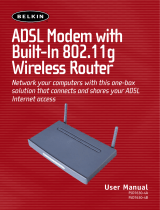
Table of Contents
Chapter 1 ................................................................................................3
1.1 Introducing the BiPAC 7300GX.............................................3
1.2 Features.................................................................................5
1.3 Applications of the BiPAC 7300GX........................................8
Chapter 2 ................................................................................................9
2.1 Important Notes...................................................................10
2.2 Package Contents ...............................................................10
2.3 The Front LEDs ................................................................... 11
2.4 The Rear Ports ....................................................................12
2.5 Cabling ................................................................................14
Chapter 3 ..............................................................................................15
3.1 Before Configuration............................................................15
3.2 Factory Default Settings ......................................................20
3.3 LAN and WAN Port Addresses............................................21
3.4 Information from your ISP....................................................22
3.5 Configuring with your BiPAC 7300GX .................................23
Chapter 4 ..............................................................................................27
4.1 Status...................................................................................28
4.2 Quick Start...........................................................................29
4.3 WAN ....................................................................................31
4.4 WLAN ..................................................................................35
Chapter 5 ..............................................................................................38
5.1 Status...................................................................................39
5.1.1 ADSL Status......................................................................41
5.1.2 3G Status..........................................................................42
5.1.2 ARP Table.........................................................................43
5.1.3 DHCP Table......................................................................44
5.1.4 System Log.......................................................................45
5.1.5 Firewall Log ......................................................................46
5.2 Quick Start...........................................................................47
5.3 Configuration .......................................................................50
5.3.1 LAN (Local Area Network)................................................51
5.3.2 WAN (Wide Area Network) ...............................................70
5.3.3 System..............................................................................81
5.3.4 Firewall .............................................................................86
5.3.5 QoS (Quality of Service)...................................................95
5.3.6 Virtual Server..................................................................100
5.3.7 Time Schedule................................................................105
5.3.8 Advanced........................................................................107
5.4 Save Configuration to Flash ..............................................121





















